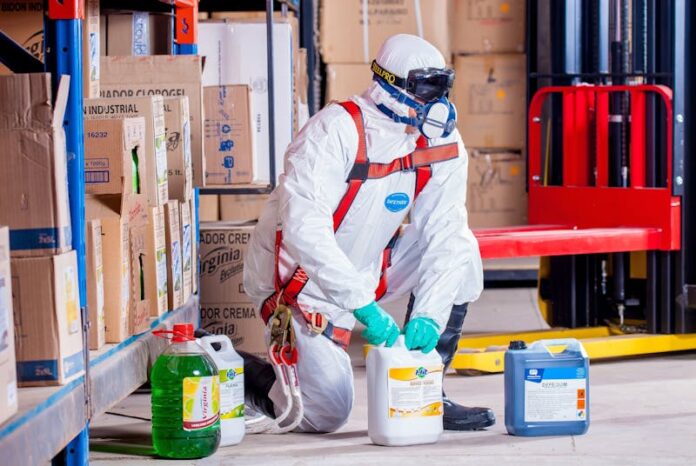The recent ban on PFAS (Per- and Poly-fluoroalkyl Substances) marks a significant step toward improving public health and environmental safety. These substances, which are sometimes called “forever chemicals,” are extensively utilized in many different sectors.
The ability of PFAS compounds to withstand heat, oil, and water is by far their greatest advantage. Nevertheless, because of their environmental durability and possible health dangers, regulatory action has been prompted by grave concerns.
In this article, we will look at the restrictions imposed on the use of PFAS chemicals.
The Move Towards a PFAS Ban
Governments and regulatory agencies throughout the globe are taking action to restrict or outlaw the use of PFAS Ban in response to mounting concerns. For example, the European Union (EU) has suggested stringent regulations on certain substances. In fact, the EU has also proposed a complete ban on the use of chemicals forever. However, a Reuters article states that the EU Commission might add some exemptions to the proposed ban.
The U.S. Environmental Protection Agency (EPA) is also taking steps to regulate PFAS more stringently. It has just imposed restrictions on the quantity of PFAS Ban in drinking water. Four parts per trillion is the maximum allowed for PFOA and PFOS in public drinking water, according to a declaration made by the FDA in April 2024.
Banning PFAS involves phasing out their use in manufacturing and consumer products. This transition is challenging due to the widespread reliance on PFAS Ban for their unique properties. However, the health benefits of such measures make the effort worthwhile. Reducing PFAS exposure can significantly lower the risk of associated health issues, contributing to overall public health improvement.
According to Just Style, around 450 more bills are waiting to be passed in the US. These bills can impose more restrictions on the use of this toxic chemical. If the bills are passed, around 35 US states could ban PFAS use.
Health Benefits of Reducing PFAS Exposure
The primary goal of banning PFAS is to reduce exposure and thereby decrease health risks. Studies have shown that PFAS Bancan accumulate in the bloodstream, leading to chronic health conditions.
A Nature study shows that exposure to long-chained PFAS chemicals can impact women’s health. Exposure to compounds like PFNA and PFUA can increase their risk of having melanoma diagnosis by two times. Lowering PFAS Ban levels in the environment and consumer products can reduce the incidence of these health issues.
There is a classification for some PFAS chemicals as possible carcinogens. By limiting exposure, the likelihood of developing cancer related to these chemicals can be decreased. Consider the example of PFAS Ban exposure among firefighters leading to several cancers.
Several studies have concluded that firefighters have an occupational risk of PFAS Ban exposure through aqueous film-forming foams (AFFF). The use of PFAS in AFFF makes them extremely effective at suppressing liquid fires. However, exposure to the chemicals makes firefighters vulnerable to numerous types of cancers.
According to TorHoerman Law, firefighters may develop the following cancers due to AFFF exposure:
- Kidney cancer
- Breast cancer
- Colorectal cancer
- Bladder cancer
- Liver cancer
- Mesothelioma
- Prostate cancer, etc.
Since firefighters were not aware of the health issues, they filed a firefighting foam lawsuit against the manufacturers. Through such a lawsuit, firefighters allege that if manufacturers had warned them, they might not have used the product. Thus, they seek fair compensation from them for putting their profits ahead of firefighters’ health.
Is It Possible to Remove PFAS from Your Body?
Over time, most PFAS are excreted from the body through urine. It’s possible that kidney disease patients eliminate less PFAS from their bodies through urine than healthy people. During menstruation, certain PFAS regularly exit the body in blood. Menstruating individuals could excrete more PFAS than non-menstruating individuals.
Environmental Impact and Public Health
Beyond direct health benefits, banning PFAS can have broader positive effects on the environment and public health. Removing PFAS from industrial processes and consumer products can reduce contamination levels in water sources. This can lead to safer drinking water and a healthier ecosystem.
The effect of PFAS on animals is another important factor to take into account. These chemicals can accumulate in animal tissues, leading to adverse health effects and affecting entire food chains. Reducing PFAS levels in the environment can improve the health of wildlife. This, in turn, benefits ecosystems and human populations that rely on these natural resources.
Can PFAS Contaminate Water?
Since PFAS may seep into both surface and groundwater, its pollution of water sources is a serious problem. Through these sources, they can enter drinking water supplied to numerous households across the US. In fact, it was found that nearly 45% of tap water systems may have one or more types of PFAS chemicals.
Challenges in Implementing a PFAS Ban
Despite the clear benefits, implementing a PFAS ban presents several challenges. Since these compounds are widely used in many different sectors, it is not always easy to find adequate substitutes. Manufacturers need to identify and test new materials that can provide similar properties without the associated health risks.
Moreover, cleaning up existing PFAS contamination is a complex and costly process. Remediation efforts require advanced technologies and significant financial investment. However, addressing contamination is important for reducing long-term exposure and associated health risks.
What Are Some Alternatives for PFAS?
Since the 1970s, aqueous film-forming foams (AFFFs) containing per- and poly-fluoroalkyl substances (PFAS) have been used to put out liquid fuel fires. Foams that are devoid of PFAS are known as fluorine-free foams. Their methods for putting out liquid fuel fires are the same.
One of the most important steps in lowering health risks and safeguarding the environment is the banning of PFAS. There are serious health risks as a result of these compounds’ enduring usage. However, regulatory actions and the development of safer alternatives offer a path forward. By addressing the challenges and working collaboratively, society can reduce exposure to PFAS and create a healthier future for all.
FOLLOW US
